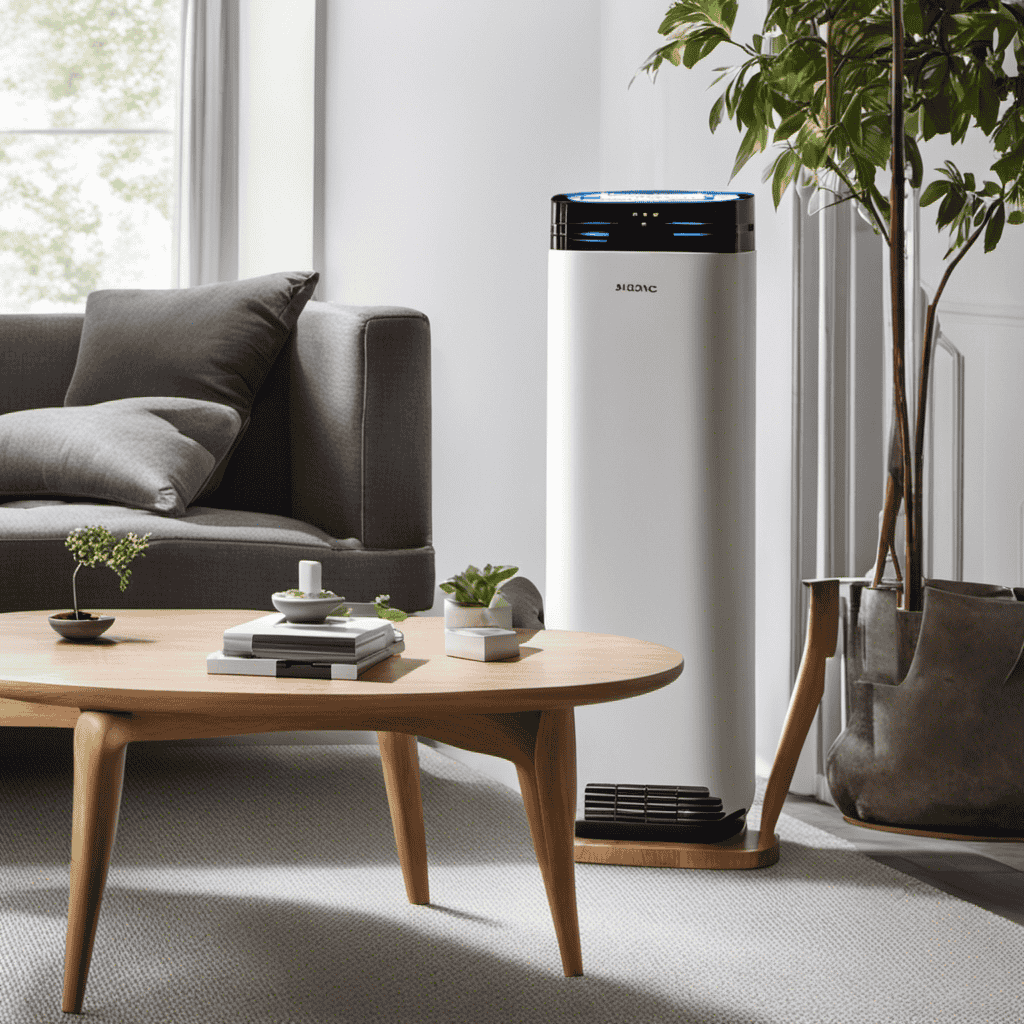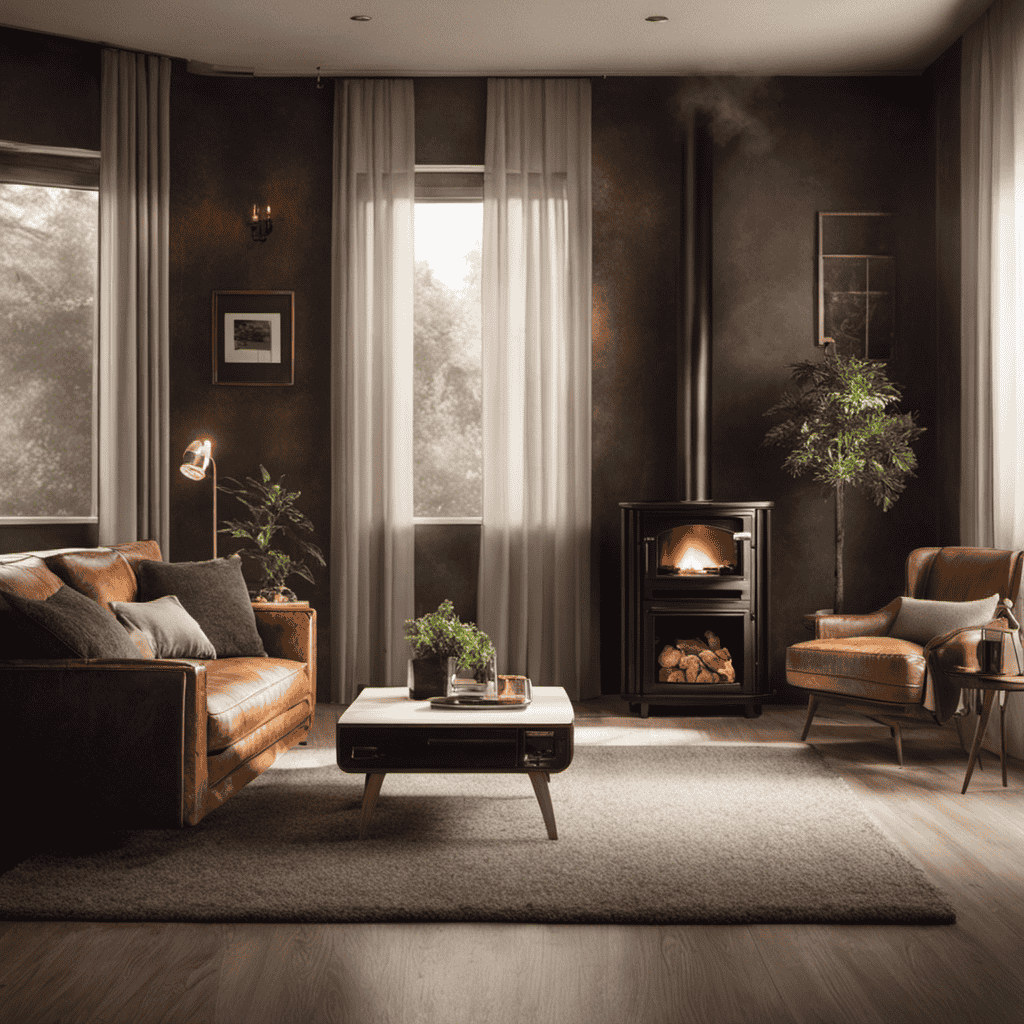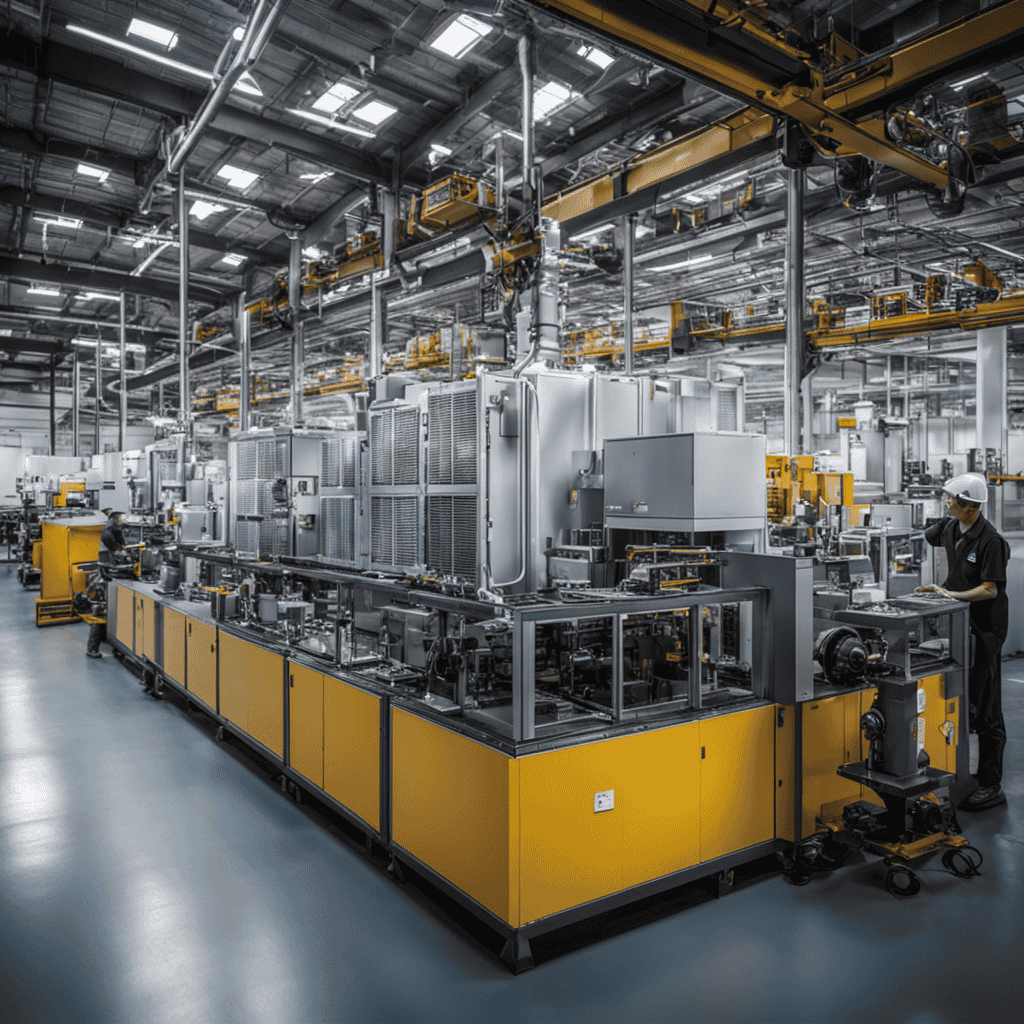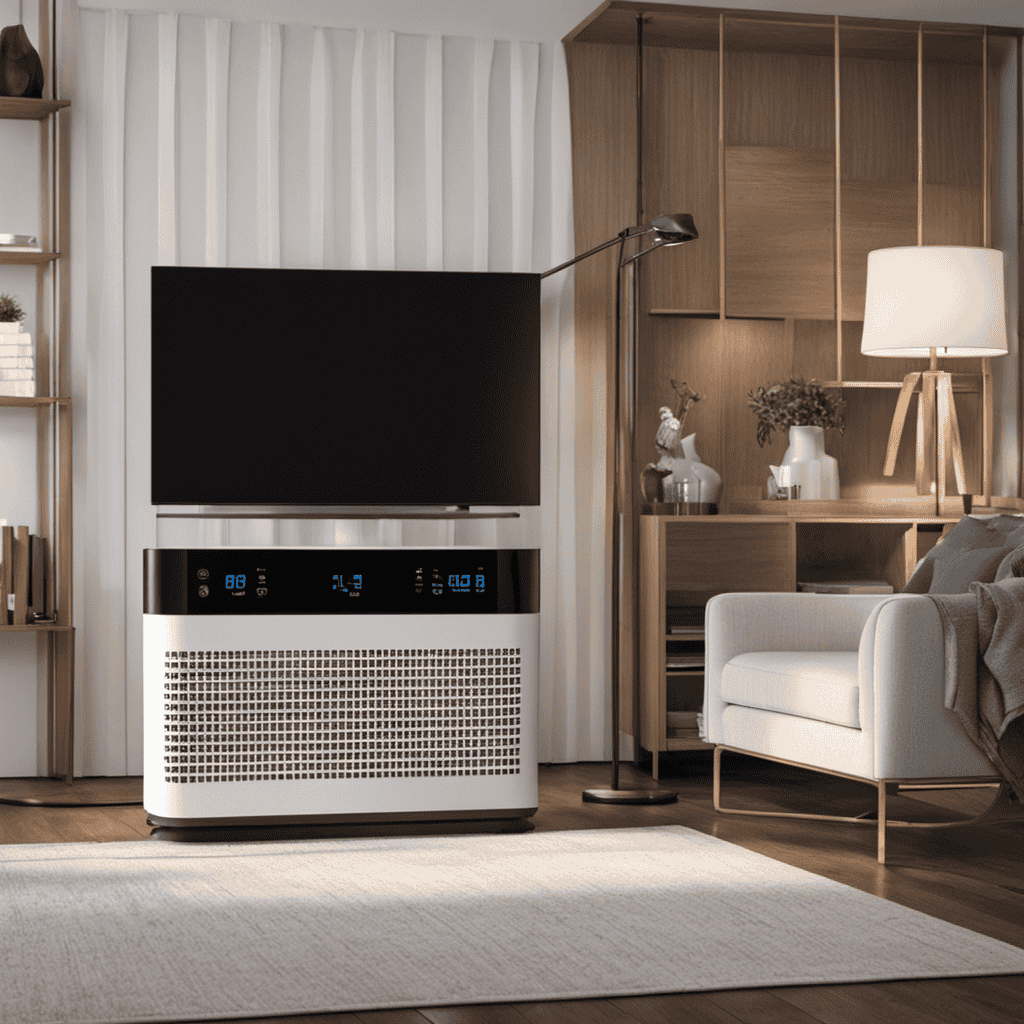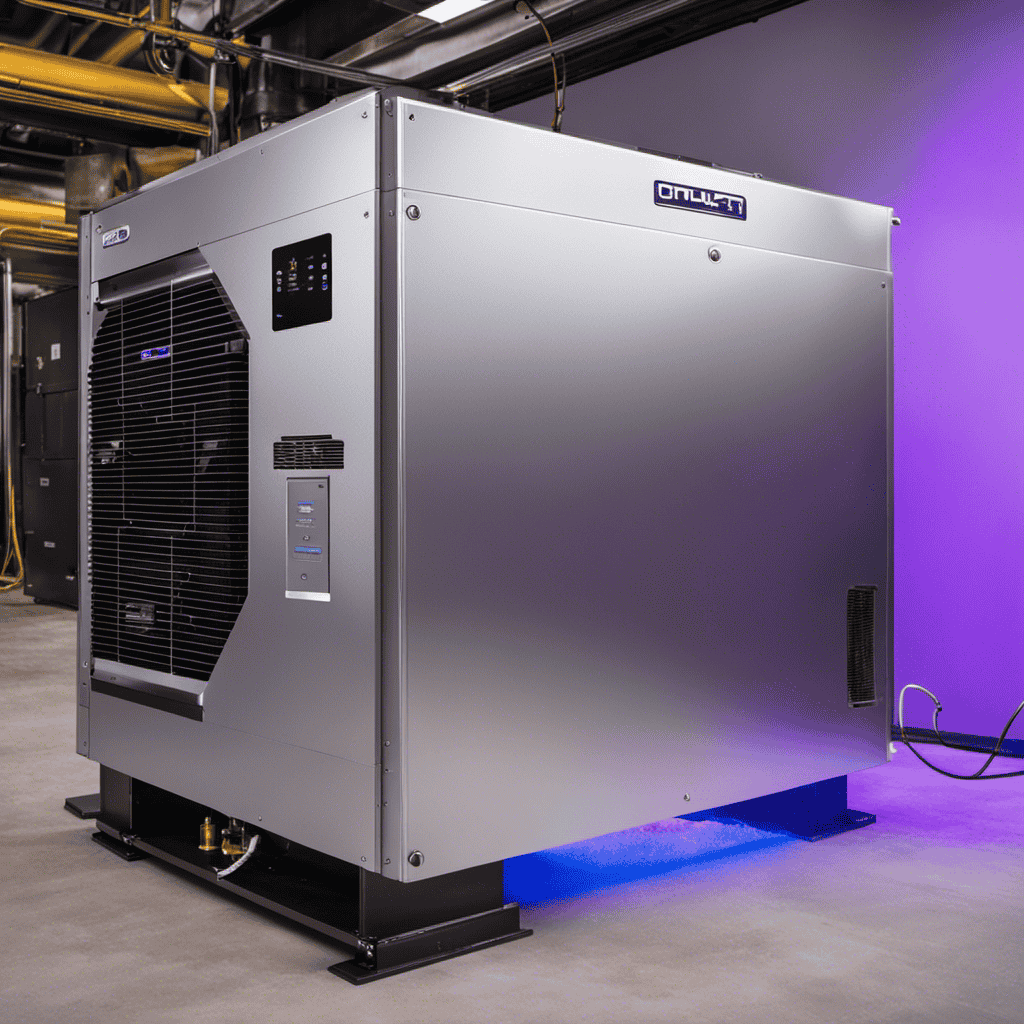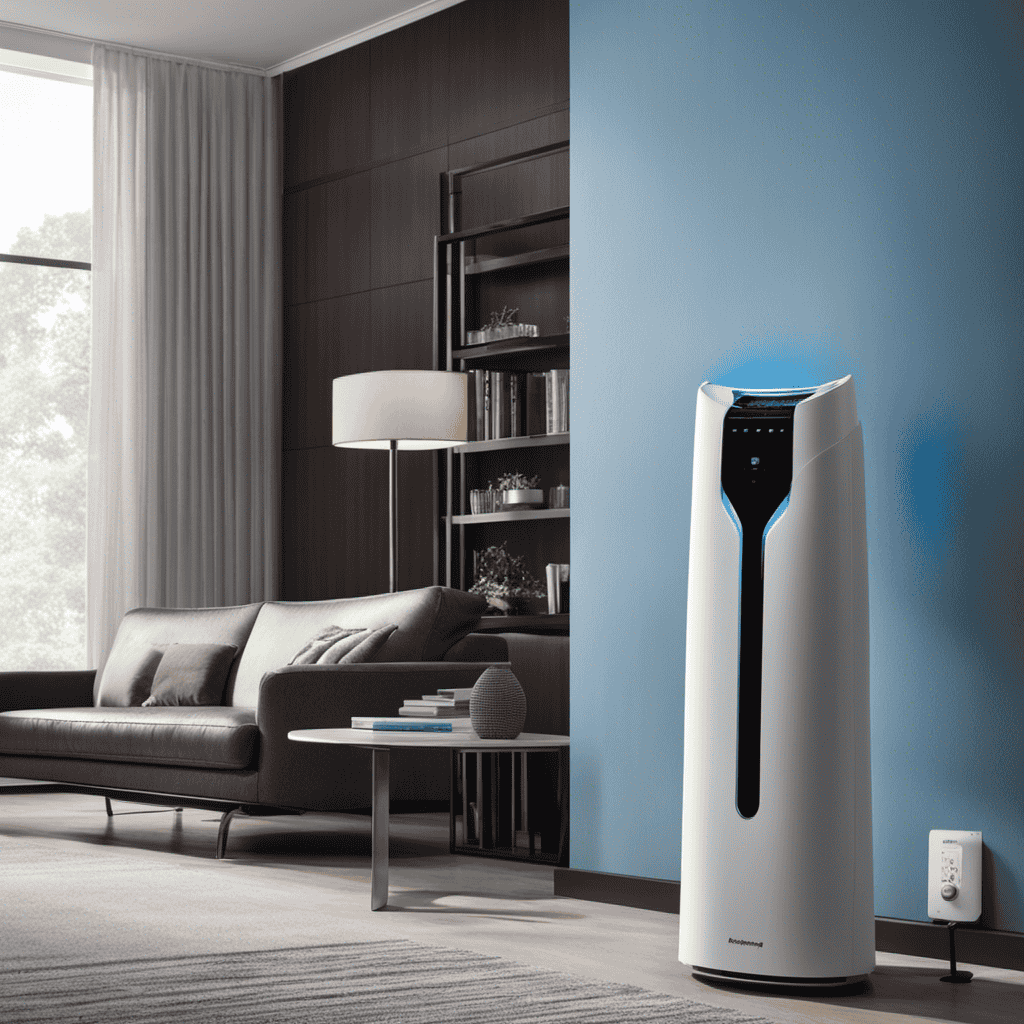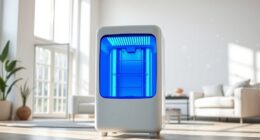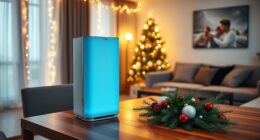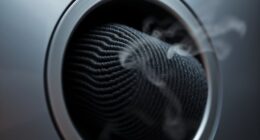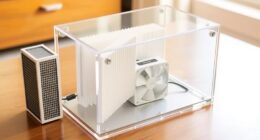I’ve always heard the expression, “Clean air is as refreshing as a breath of fresh life.” And that’s precisely what an ionic air purifier accomplishes – it revitalizes the air we breathe.
This remarkable device uses ions to eliminate common pollutants and improve indoor air quality.
In this article, we’ll explore how an ionic air purifier works, the benefits it offers, and what factors to consider when choosing one.
So buckle up, because we’re about to dive into the science of clean air.
Key Takeaways
- Ionic air purifiers use negatively charged ions to attract and remove airborne particles.
- They efficiently filter dust, pollen, pet dander, and other allergens from the air.
- Ionic air purifiers neutralize odor-causing molecules, eliminating unpleasant odors.
- They improve indoor air quality, reducing respiratory issues and creating a healthier living environment.
How Does an Ionic Air Purifier Work
If you want to know how an ionic air purifier works, it uses negatively charged ions to attract and remove airborne particles from the air in your home.
The main mechanism of an ionic air purifier is ion production. Inside the purifier, there is a needle-like electrode that emits a stream of negatively charged ions into the air.
These ions attach themselves to positively charged particles such as dust, pollen, and smoke, creating larger particles called ion clusters.
These ion clusters become heavy and fall to the ground or are captured by the purifier’s collection plates.
This process effectively removes these particles from the air, improving the overall air quality in your home.
This air purification mechanism is based on the principles of electrostatic attraction and ionization.
Benefits of Using an Ionic Air Purifier
You can experience cleaner and fresher indoor air by using an ionic air purifier. Ionic air purifiers use advanced air purifier technology to effectively remove pollutants and allergens from the air. Here are some advantages of using an ionic air purifier:
-
Efficient filtration: Ionic air purifiers use electrostatically charged plates to attract and trap airborne particles like dust, pollen, and pet dander. This ensures that the air you breathe is free from these harmful substances.
-
Odor elimination: Ionic air purifiers also help eliminate unpleasant odors by neutralizing the molecules that cause them. This is particularly beneficial for those who have pets or live in areas with high pollution levels.
-
Silent operation: Unlike traditional air purifiers that use fans, ionic air purifiers operate silently. This makes them ideal for use in bedrooms, offices, and other quiet spaces.
Investing in an ionic air purifier can greatly improve the quality of your indoor air, leading to a healthier and more comfortable living environment.
The Role of Ions in Air Purification
When it comes to air purification, the interaction between ions and pollutants plays a crucial role.
Ions, which are charged particles, can attach themselves to pollutants in the air, causing them to become heavier and fall to the ground.
This process, known as ionization, helps to remove harmful particles from the air, improving its quality and reducing the risks of respiratory issues and allergies.
Ionization and Pollutants Interaction
Ionization reduces the concentration of pollutants in the air. When pollutants are subjected to the process of ionization, they become charged particles, which can then interact with other ionized particles in the air. This interaction leads to the formation of larger particles that are more easily captured by air purifiers or removed from the air through natural processes such as settling or precipitation.
The effectiveness of pollutant ionization depends on several factors, including the type and size of the pollutants, the concentration of ions in the air, and the presence of other gases or particles that may interfere with the ionization process.
Overall, ionization plays a crucial role in improving indoor air quality by reducing the levels of harmful pollutants in the air.
- Ionization transforms pollutants into charged particles
- Ionized particles interact with other ionized particles in the air
- Interaction leads to the formation of larger particles that are easier to remove from the air.
Benefits of Ion Purification
The benefits of ion purification include improved indoor air quality and reduced levels of harmful pollutants. Ion purification is an effective method of air purification that uses negative ions to charge and neutralize airborne contaminants.
These negative ions attach themselves to particles such as dust, pollen, and pet dander, causing them to become too heavy to remain airborne. As a result, these pollutants settle on surfaces and can be easily removed through regular cleaning.
One of the advantages of ion purification is that it does not require the use of filters, making it a low-maintenance option. Additionally, ion purifiers can help remove odors and allergens from the air, leading to a fresher and healthier environment.
However, it’s important to note that ionizers can produce small amounts of ozone, which may be a potential drawback for individuals with respiratory conditions. When compared to other air purification methods like HEPA filters or activated carbon, ion purification offers a different approach to improving indoor air quality.
Common Pollutants Removed by Ionic Air Purifiers
Harmful airborne particles can have a significant impact on indoor air quality. These particles, such as dust, pollen, and pet dander, can contribute to respiratory issues and allergies.
It is crucial to understand the sources of these pollutants and how they can be effectively removed to improve the overall air quality in indoor environments.
Harmful Airborne Particles
Airborne particles, such as dust and pollen, can be reduced by using an ionic air purifier. These devices work by emitting negative ions into the air, which attach themselves to the positively charged airborne contaminants, causing them to become heavy and fall to the ground or stick to surfaces. Ionic air purifiers are effective at removing a wide range of airborne contaminants, including allergens, bacteria, and viruses.
The negative ions emitted by the purifier can also neutralize harmful pollutants, such as cigarette smoke or volatile organic compounds (VOCs). Ionic air purifiers are known for their ability to improve air quality without the need for filters, making them a low-maintenance option.
Unlike some other air purification techniques, ionic air purifiers do not produce ozone as a byproduct, ensuring a safer indoor environment.
Indoor Air Quality
Improving indoor air quality is essential for your health and well-being. Clean air is crucial for maintaining a healthy living environment, as it can help prevent respiratory problems and allergies.
Air purifiers play a significant role in achieving clean air by removing harmful particles such as dust, pollen, pet dander, and mold spores. These devices utilize advanced technology to capture and trap these particles, improving the overall air quality in your home.
The benefits of using an air purifier include reducing the risk of respiratory issues, improving sleep quality, and creating a fresh and clean environment.
Understanding the technology behind ionic air purifiers will further enhance your knowledge of how these devices work to provide you with clean and fresh indoor air.
Understanding the Technology Behind Ionic Air Purifiers
Ionic air purifiers use negative ions to remove pollutants from the air. These devices work by releasing negatively charged ions, which attach to positively charged particles in the air, such as dust, allergens, and smoke. The ions neutralize the particles, causing them to cluster together and become too heavy to remain airborne. As a result, the pollutants are effectively removed from the air, improving indoor air quality.
The role of ions in cleaning the air is crucial for ionic air purifiers. Unlike traditional air purifiers that rely on filters to trap particles, ionic air purifiers use ions to actively eliminate pollutants. This method offers several advantages over traditional purifiers:
- Efficiency: Ionic air purifiers can remove particles as small as 0.01 microns, whereas traditional purifiers may struggle with particles smaller than 0.3 microns.
- Maintenance: Ionic air purifiers do not require frequent filter replacements, reducing long-term costs.
- Silent operation: Since they don’t rely on fans or motors, ionic air purifiers operate quietly.
Overall, ionic air purifiers offer a unique and effective approach to improving indoor air quality by utilizing the power of negative ions.
Factors to Consider When Choosing an Ionic Air Purifier
When choosing an ionic air purifier, it’s important to consider factors such as size, noise level, and maintenance requirements. These factors can greatly impact the effectiveness and convenience of the device.
| Factors to Consider | Explanation |
|---|---|
| Size | Ensure the purifier is suitable for the room size. |
| Noise Level | Consider the noise produced by the purifier. |
| Maintenance Requirements | Look into the cleaning and filter replacement needs. |
The size of the air purifier is crucial as it determines how effectively it can clean the air in a specific room. Choosing a purifier that is too small for the room may result in inadequate purification. On the other hand, selecting a purifier that is too large can be unnecessary and wasteful.
The noise level is another essential factor to consider, especially if you plan to use the purifier in a bedroom or office. Some ionic air purifiers can produce noise that may disrupt sleep or concentration.
Maintenance requirements vary among different models. It is important to consider how often the filters need to be replaced and how easy it is to clean the unit. Neglecting maintenance can compromise the purifier’s performance.
Considering these factors will help you choose the right ionic air purifier for your needs.
Frequently Asked Questions
Are Ionic Air Purifiers Safe to Use Around Children and Pets?
Yes, ionic air purifiers are safe to use around children and pets. They use negatively charged ions to remove pollutants from the air, without producing harmful byproducts like ozone.
Can an Ionic Air Purifier Eliminate Odors From Cooking and Smoking?
Yes, an ionic air purifier can eliminate odors from cooking and smoking. It uses negatively charged ions to attract and remove odor-causing particles, providing the benefits of removing household odors.
Do Ionic Air Purifiers Produce Any Noise While Operating?
When it comes to noise production, ionic air purifiers are surprisingly quiet. I’ve never heard a peep out of mine! It’s a great feature, especially if you have kids or pets around.
How Long Do the Ionization Plates in an Ionic Air Purifier Last Before They Need to Be Replaced?
The ionization plates in an ionic air purifier typically last for a certain period of time before they need to be replaced. The lifespan and replacement frequency of these plates depend on various factors.
Can an Ionic Air Purifier Effectively Remove Allergens Like Pollen and Pet Dander From the Air?
An ionic air purifier effectively removes allergens like pollen and pet dander from the air. It can reduce mold spores and dust mites, improving indoor air quality and respiratory health.
What Is the Purpose of an Ionic Air Purifier?
The purpose of an ionic air purifier functioning is to improve indoor air quality by removing harmful airborne particles. These devices use negatively charged ions to attract and remove pollutants like dust, pollen, and pet dander from the air, helping to create a cleaner and healthier living environment.
Conclusion
After researching and understanding the technology behind ionic air purifiers, it’s ironic to think that these devices, which claim to improve air quality, actually release ozone, a known respiratory irritant. While they may remove some pollutants, it’s crucial to consider the potential harm they can cause.
When choosing an air purifier, it’s important to prioritize safety and effectiveness. Exploring alternative methods, such as HEPA filters, might be a wiser choice for those seeking a truly clean and healthy environment.
